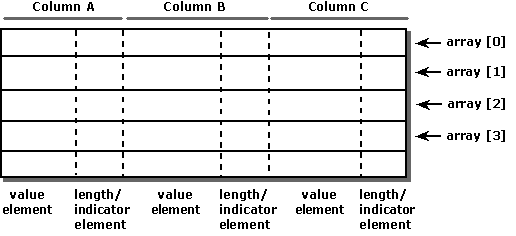Associação de linha
Ao usar a vinculação por linha, um aplicativo define uma estrutura que contém um, dois ou, em alguns casos, três elementos para cada coluna para a qual os dados devem ser retornados. O primeiro elemento contém o valor dos dados, e o segundo elemento contém o buffer de comprimento/indicador. Indicadores e valores de comprimento podem ser armazenados em buffers separados por meio da configuração dos campos dos descritores SQL_DESC_INDICATOR_PTR e SQL_DESC_OCTET_LENGTH_PTR com valores diferentes. Se isso for feito, a estrutura conterá um terceiro elemento. O aplicativo alocará então uma matriz dessas estruturas, que conterá tantos elementos quantas linhas houver no conjunto de linhas.
O aplicativo declara o tamanho da estrutura para o driver com o atributo de instrução SQL_ATTR_ROW_BIND_TYPE e associa o endereço de cada membro no primeiro elemento da matriz. Assim, o driver pode calcular o endereço dos dados para determinada linha e coluna como
Address = Bound Address + ((Row Number - 1) * Structure Size)
em que as linhas são numeradas de 1 até o tamanho do conjunto de linhas. (Um é subtraído do número da linha, pois a indexação da matriz em C é com base em zero.) A ilustração a seguir mostra como funciona a associação por linha. Geralmente, apenas as colunas que serão vinculadas são incluídas na estrutura. A estrutura pode conter campos não relacionados às colunas do conjunto de resultados. As colunas podem ser colocadas na estrutura em qualquer ordem, mas são mostradas em ordem sequencial, para maior clareza.

Por exemplo, o código a seguir cria uma estrutura com elementos a fim de retornar dados para as colunas OrderID, SalesPerson e Status e comprimento/indicadores para as colunas SalesPerson e Status. Ele aloca 10 dessas estruturas e as vincula às colunas OrderID, SalesPerson e Status.
#define ROW_ARRAY_SIZE 10
// Define the ORDERINFO struct and allocate an array of 10 structs.
typedef struct {
SQLUINTEGER OrderID;
SQLINTEGER OrderIDInd;
SQLCHAR SalesPerson[11];
SQLINTEGER SalesPersonLenOrInd;
SQLCHAR Status[7];
SQLINTEGER StatusLenOrInd;
} ORDERINFO;
ORDERINFO OrderInfoArray[ROW_ARRAY_SIZE];
SQLULEN NumRowsFetched;
SQLUSMALLINT RowStatusArray[ROW_ARRAY_SIZE], i;
SQLRETURN rc;
SQLHSTMT hstmt;
// Specify the size of the structure with the SQL_ATTR_ROW_BIND_TYPE
// statement attribute. This also declares that row-wise binding will
// be used. Declare the rowset size with the SQL_ATTR_ROW_ARRAY_SIZE
// statement attribute. Set the SQL_ATTR_ROW_STATUS_PTR statement
// attribute to point to the row status array. Set the
// SQL_ATTR_ROWS_FETCHED_PTR statement attribute to point to
// NumRowsFetched.
SQLSetStmtAttr(hstmt, SQL_ATTR_ROW_BIND_TYPE, sizeof(ORDERINFO), 0);
SQLSetStmtAttr(hstmt, SQL_ATTR_ROW_ARRAY_SIZE, ROW_ARRAY_SIZE, 0);
SQLSetStmtAttr(hstmt, SQL_ATTR_ROW_STATUS_PTR, RowStatusArray, 0);
SQLSetStmtAttr(hstmt, SQL_ATTR_ROWS_FETCHED_PTR, &NumRowsFetched, 0);
// Bind elements of the first structure in the array to the OrderID,
// SalesPerson, and Status columns.
SQLBindCol(hstmt, 1, SQL_C_ULONG, &OrderInfoArray[0].OrderID, 0, &OrderInfoArray[0].OrderIDInd);
SQLBindCol(hstmt, 2, SQL_C_CHAR, OrderInfoArray[0].SalesPerson,
sizeof(OrderInfoArray[0].SalesPerson),
&OrderInfoArray[0].SalesPersonLenOrInd);
SQLBindCol(hstmt, 3, SQL_C_CHAR, OrderInfoArray[0].Status,
sizeof(OrderInfoArray[0].Status), &OrderInfoArray[0].StatusLenOrInd);
// Execute a statement to retrieve rows from the Orders table.
SQLExecDirect(hstmt, "SELECT OrderID, SalesPerson, Status FROM Orders", SQL_NTS);
// Fetch up to the rowset size number of rows at a time. Print the actual
// number of rows fetched; this number is returned in NumRowsFetched.
// Check the row status array to print only those rows successfully
// fetched. Code to check if rc equals SQL_SUCCESS_WITH_INFO or
// SQL_ERRORnot shown.
while ((rc = SQLFetchScroll(hstmt,SQL_FETCH_NEXT,0)) != SQL_NO_DATA) {
for (i = 0; i < NumRowsFetched; i++) {
if (RowStatusArray[i] == SQL_ROW_SUCCESS|| RowStatusArray[i] ==
SQL_ROW_SUCCESS_WITH_INFO) {
if (OrderInfoArray[i].OrderIDInd == SQL_NULL_DATA)
printf(" NULL ");
else
printf("%d\t", OrderInfoArray[i].OrderID);
if (OrderInfoArray[i].SalesPersonLenOrInd == SQL_NULL_DATA)
printf(" NULL ");
else
printf("%s\t", OrderInfoArray[i].SalesPerson);
if (OrderInfoArray[i].StatusLenOrInd == SQL_NULL_DATA)
printf(" NULL\n");
else
printf("%s\n", OrderInfoArray[i].Status);
}
}
}
// Close the cursor.
SQLCloseCursor(hstmt);